JVC KD-G632 User Manual
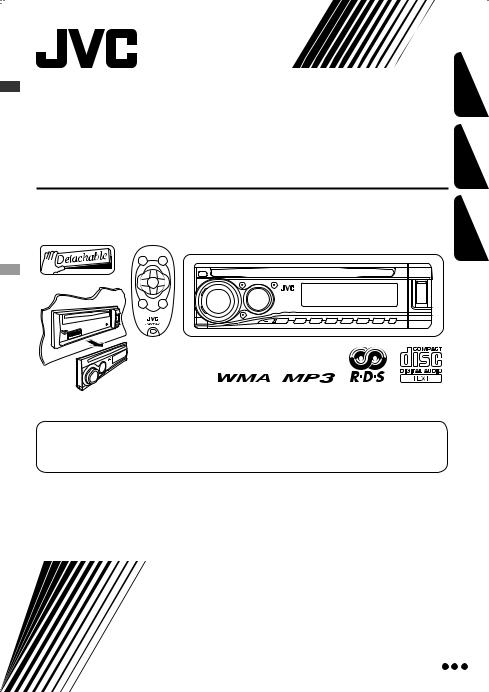
CD RECEIVER
CD-RECEIVER
РЕСИВЕР С ПРОИГРЫВАТЕЛЕМ КОМПАКТ-ДИСКОВ
KD-G632/KD-G631
For canceling the display demonstration, see page 7. Zum Abbrechen der Displaydemonstration siehe Seite 7.
Информацию об отмене демонстрации функций дисплея см. на стр. 7.
For installation and connections, refer to the separate manual.
Für den Einbau und die Anschlüsse siehe das eigenständige Handbuch.
Указания по установке и выполнению соединений приводятся в отдельной инструкции.
РУCCKИЙ DEUTSCH ENGLISH
INSTRUCTIONS
BEDIENUNGSANLEITUNG
ИНСТРУКЦИИ ПО ЭКСПЛУАТАЦИИ
GET0424-006A
[EY]
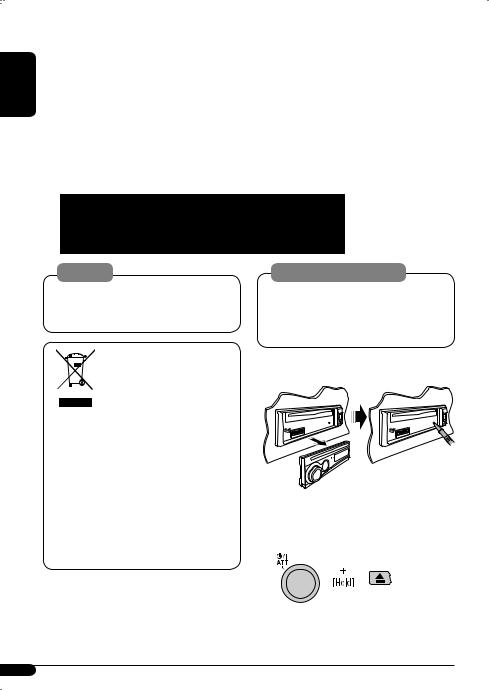
ENGLISH
Thank you for purchasing a JVC product.
Please read all instructions carefully before operation, to ensure your complete understanding and to obtain the best possible performance from the unit.
IMPORTANT FOR LASER PRODUCTS
1.CLASS 1 LASER PRODUCT
2.CAUTION: Do not open the top cover. There are no user serviceable parts inside the unit; leave all servicing to qualified service personnel.
3.CAUTION: Visible and/or invisible class 1M laser radiation when open. Do not view directly with optical instruments.
4.REPRODUCTION OF LABEL: CAUTION LABEL, PLACED OUTSIDE THE UNIT.
Warning: |
Caution on volume setting: |
If you need to operate the unit while driving, be sure to look ahead carefully or you may be involved in a traffic accident.
This symbol is only valid in the European Union.
Information for Users on Disposal of Old Equipment
This symbol indicates that the product with this symbol should not be disposed as general
household waste at its end-of-life. If you wish to dispose of this product, please do so in accordance with applicable national legislation or other rules in your country and municipality. By disposing of this product correctly, you will help to conserve natural resources and will help prevent potential negative effects on the environment and human health.
For security reasons, a numbered ID card is provided with this unit, and the same ID number is imprinted on the unit’s chassis. Keep the card in a safe place, as it will help the authorities to identify your unit if stolen.
Discs produce very little noise compared with other sources. Lower the volume before playing a disc
to avoid damaging the speakers by the sudden increase of the output level.
 How to reset your unit
How to reset your unit
• Your preset adjustments will also be erased.
 How to forcibly eject a disc
How to forcibly eject a disc
•Be careful not to drop the disc when it ejects.
•If this does not work, reset your unit.
2
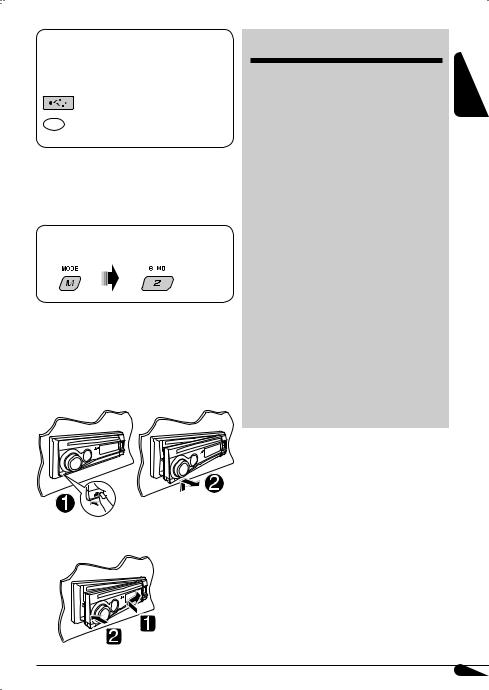
The following marks are used to indicate...
 : Built-in CD player operations.
: Built-in CD player operations.
 : External CD changer operations. : External USB memory operations.
: External CD changer operations. : External USB memory operations.
:Indicator displayed for the corresponding operation.
 How to use the M MODE button
How to use the M MODE button
If you press M MODE, the unit goes into functions mode, then the number buttons and 5/∞buttons work as different function buttons.
Ex.: When number button 2 works as
MO (monaural) button.
To use these buttons for their original functions again after pressing M MODE, wait for 5 seconds without pressing any of these buttons until the functions mode is cleared or press M MODE again.
 Detaching the control panel
Detaching the control panel
 Attaching the control panel
Attaching the control panel
CONTENTS |
|
Control panel — KD-G632/KD-G631....... |
4 |
Remote controller — RM-RK50........... |
5 |
Getting started................................ |
6 |
Basic operations................................................... |
6 |
Radio operations ............................. |
7 |
FM RDS operations........................... |
8 |
Searching for your favorite FM RDS programme ... |
8 |
Disc / USB memory operations........... |
11 |
Playing a disc in the unit ..................................... |
11 |
Playing discs in the CD changer ........................... |
11 |
Playing from a USB memory ................................ |
11 |
Sound adjustments.......................... |
14 |
General settings — PSM .................. |
15 |
DAB tuner operations....................... |
18 |
iPod/D. player operations................. |
19 |
Other external component operations... |
21 |
Maintenance ................................... |
22 |
More about this unit ........................ |
23 |
Troubleshooting.............................. |
26 |
Specifications.................................. |
29 |
For safety...
•Do not raise the volume level too much, as this will block outside sounds, making driving dangerous.
•Stop the car before performing any complicated operations.
Temperature inside the car...
If you have parked the car for a long time in hot or cold weather, wait until the temperature in the car becomes normal before operating the unit.
ENGLISH
3
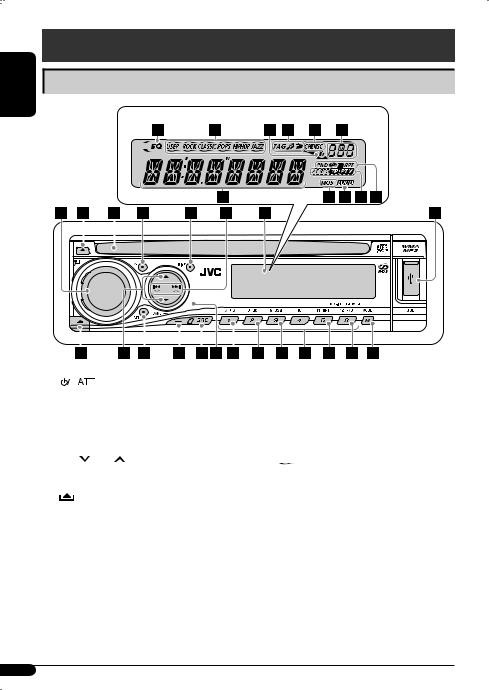
ENGLISH
Control panel — KD-G632 / KD-G631
Parts identification
Display window
|
|
|
|
|
|
|
|
|
|
|
|
|
|
|
|
|
|
|
|
|
|
|
|
|
|
|
|
|
|
|
|
|
|
|
|
|
|
|
|
|
|
|
|
|
|
|
|
|
|
|
|
|
|
|
|
|
|
|
|
1 |
|
|
|
(standby/on attenuator) button / |
|||||
|
|
|
|||||||
|
|
|
|||||||
|
Control dial |
||||||||
2 |
0(eject) button |
||||||||
3 |
Loading slot |
||||||||
4 |
T/P (traffic programme/programme type) button |
||||||||
5 |
DISP (display) button |
||||||||
6 |
4 /¢ buttons |
||||||||
7 |
Display window |
||||||||
8 |
USB (Universal Serial Bus) input terminal |
||||||||
9 |
|
(control panel release) button |
|||||||
p 5(up) / ∞(down) buttons q SEL (select) button
w BAND button
e SRC (source) button
rRemote sensor
DO NOT expose the remote sensor to strong light (direct sunlight or artificial lighting).
t EQ (equalizer) button y MO (monaural) button
u SSM (Strong-station Sequential Memory) button i Number buttons
o RPT (repeat) button
; RND (random) button a M MODE button
s EQ (equalizer) indicator
dSound mode (iEQ: intelligent equalizer) indicators—USER, ROCK, CLASSIC, POPS, HIP HOP, JAZZ
•  lights up for the selected item. f Tr (track) indicator
lights up for the selected item. f Tr (track) indicator
gDisc information indicators—
TAG (Tag information), (track/file),
(track/file),  (folder)
(folder)
hPlayback source indicators—
CH: Lights up only when CD-CH is selected as the playback source.
DISC: Lights up for the built-in CD player.
j Source display / Time countdown indicator k Main display
lTuner reception indicators—MO (monaural), ST (stereo)
/ LOUD (loudness) indicator
z RDS indicators—AF, REG, TP, PTY
xPlayback mode / item indicators—RND (random),  (disc),
(disc),  (folder), RPT (repeat)
(folder), RPT (repeat)
4
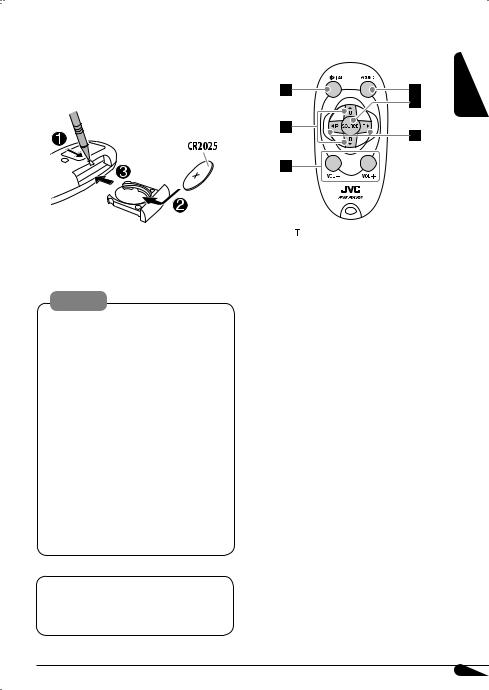
Remote controller — RM-RK50 |
|
Main elements and features |
|
|
|
 Installing the lithium coin battery (CR2025)
Installing the lithium coin battery (CR2025)
ENGLISH
Aim the remote controller directly at the remote sensor on the unit. Make sure there is no obstacle in between.
Warning:
•Do not install any battery other than CR2025 or its equivalent; otherwise, it may explode.
•Do not leave the remote controller in a place (such as dashboards) exposed to direct sunlight for a long time; otherwise, it may explode.
•Store the battery in a place where children cannot reach to avoid risk of accident.
•To prevent the battery from over-heating, cracking, or starting a fire:
–Do not recharge, short, disassemble, heat the battery, or dispose of it in a fire.
–Do not leave the battery with other metallic materials.
–Do not poke the battery with tweezers or similar tools.
–Wrap the battery with tape and insulate when throwing away or saving it.
This unit is equipped with the steering wheel remote control function.
•See the Installation/Connection Manual (separate volume) for connection.
1
 (standby/on/attenuator) button
(standby/on/attenuator) button
•Turns the power on if pressed briefly or attenuates the sound when the power is on.
•Turns the power off if pressed and held. 2 5U (up) / D (down) ∞buttons
•Changes the FM/AM/DAB bands with 5U.
•Changes the preset stations (or DAB services) with D ∞.
•Changes the folder of the MP3/WMA/USB.
•While playing an MP3 disc on an MP3-compatible CD changer:
–Changes the disc if pressed briefly.
–Changes the folder if pressed and held.
•While listening to an Apple iPod or a JVC D. player:
–Pauses/stops or resumes playback with D ∞.
–Enters the main menu with 5U.
(Now 5U/D ∞/2R/F 3work as the menu selecting buttons.)*
3VOL – / VOL + buttons
•Adjusts the volume level. 4 SOUND button
•Selects the sound mode (iEQ: intelligent
equalizer).
5SOURCE button
• Selects the source.
*5U : Returns to the previous menu. D ∞ : Confirms the selection.
Continued on the next page
5
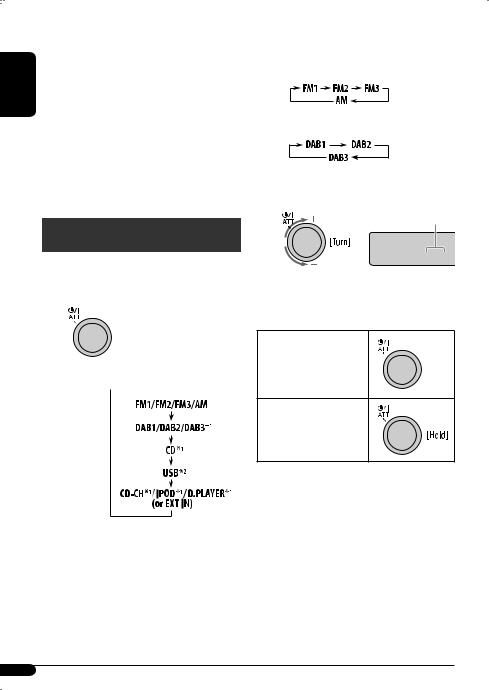
|
6 2R (reverse) / F (forward) 3buttons |
|
• Searches for stations (or DAB services) if pressed |
ENGLISH |
briefly. |
held. |
|
|
• Searches for DAB ensembles if pressed and held. |
|
• Fast-forwards or reverses the track if pressed and |
|
• Changes the tracks if pressed briefly. |
|
• While listening to an iPod or a D. player (in menu |
|
selecting mode): |
|
– Selects an item if pressed briefly. (Then, press |
|
D ∞to confirm the selection.) |
|
– Skips 10 items at a time if pressed and held. |
Getting started
Basic operations 
~ Turn on the power.
Ÿ 

*1 You cannot select these sources if they are not ready or not connected.
*2 “NO USB” appears if USB memory is not attached.
!



•For FM/AM tuner
•For DAB tuner
⁄ Adjust the volume.
Volume level appears.
VOL 20
@Adjust the sound as you want. (See pages 14 and 15.)
To drop the volume in a moment (ATT)
To restore the sound, press the button again.
To turn off the power
6
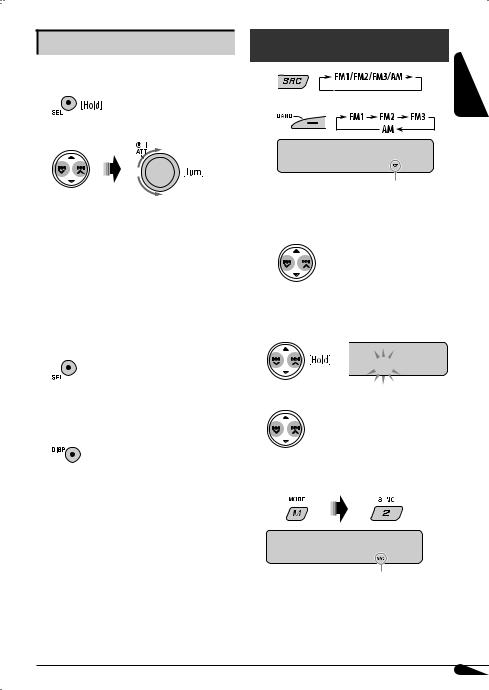
Basic settings
•See also “General settings — PSM” on pages 15 – 17.
1
2
1Canceling the display demonstrations
Select “DEMO,” then “DEMO OFF.”
2Setting the clock
Select “CLOCK H” (hour), then adjust the hour. Select “CLOCK M” (minute), then adjust the minute.
Select “24H/12H,” then “24H” (hour) or “12H” (hour).
3 Finish the procedure.
To check the current clock time while the power is turned off
Clock time is shown on the display for about 5 seconds. See also page 16.
Radio operations
~ |
ENGLISH |
|
|
Ÿ |
|
88.3
Lights up when receiving an FM stereo broadcast with sufficient signal strength.
! Start searching for a station.
When a station is received, searching stops.
To stop searching, press the same button again.
To tune in to a station manually
In step !above...
1
 M
M
2 Select a desired station frequency.
When an FM stereo broadcast is hard to receive
MONO
Lights up when monaural mode is activated.
Reception improves, but stereo effect will be lost.
To restore the stereo effect, repeat the same procedure. “MONO OFF” appears and the MO indicator goes off.
7

ENGLISH
Storing stations in memory
You can preset six stations for each band.
 FM station automatic presetting— SSM (Strong-station Sequential Memory)
FM station automatic presetting— SSM (Strong-station Sequential Memory)
1Select the FM band (FM1 – FM3) you want to store into.
2
3
 SSM
SSM
“SSM” flashes, then disappears when automatic presetting is over.
Local FM stations with the strongest signals are searched and stored automatically in the FM band.
 Manual presetting
Manual presetting
Ex.: Storing FM station of 92.5 MHz into preset number 4 of the FM1 band.
1 


Listening to a preset station
1 
2 Select the preset station (1 – 6) you want.
To check the current clock time while listening to an FM (non-RDS) or AM station
• For FM RDS stations, see page 10.
Frequency Ô Clock
FM RDS operations
What you can do with RDS
RDS (Radio Data System) allows FM stations to send an additional signal along with their regular programme signals.
By receiving the RDS data, this unit can do the following:
•Programme Type (PTY) Search (see the following)
•TA (Traffic Announcement) and PTY Standby Receptions (see pages 9 and 16)
•Tracing the same programme automatically —Network-Tracking Reception (see page 10)
•Programme Search (see pages 10 and 16)
2
|
92.5 |
3 |
Preset number flashes for a while. |
 P4
P4 
Searching for your favorite FM RDS programme 
You can tune in to a station broadcasting your favorite programme by searching for a PTY code.
•To store your favorite programme types, see the following.
~ |
|
The last selected PTY code |
|
||
|
|
appears. |
8
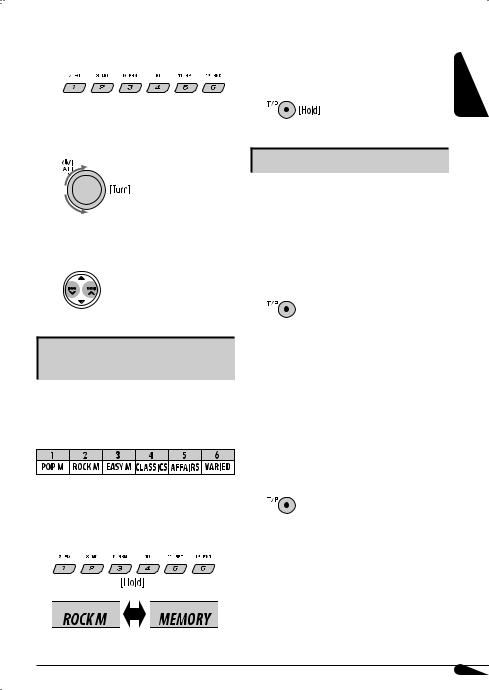
ŸSelect one of your favorite programme types.
or
Select one of the PTY codes (see page 10).
!Start searching for your favorite programme.
If there is a station broadcasting a programme of the same PTY code as you have selected, that station is tuned in.
Storing your favorite programme types
You can store six favorite programme types.
Preset programme types in the number buttons (1 to 6):
1 Select a PTY code (see above).
2Select the preset number (1 – 6) you want to store into.
Ex.: When “ROCK M” is selected
3Repeat steps 1 and 2 to store other PTY codes into other preset numbers.
4 |
Finish the procedure. |
ENGLISH |
|
Using the standby receptions
 TA Standby Reception
TA Standby Reception
TA Standby Reception allows the unit to switch temporarily to Traffic Announcement (TA) from any source other than AM.
The volume changes to the preset TA volume level if the current level is lower than the preset level (see page 16).
To activate TA Standby Reception
The TP (Traffic Programme) indicator either lights up or flashes.
•If the TP indicator lights up, TA Standby Reception is activated.
•If the TP indicator flashes, TA Standby Reception is not yet activated. (This occurs when you are listening to an FM station without the RDS signals required for TA Standby Reception.)
To activate TA Standby Reception, tune in to another station providing these signals. The TP indicator will stop flashing and remain lit.
To deactivate the TA Standby Reception
The TP indicator goes off.
Continued on the next page
9
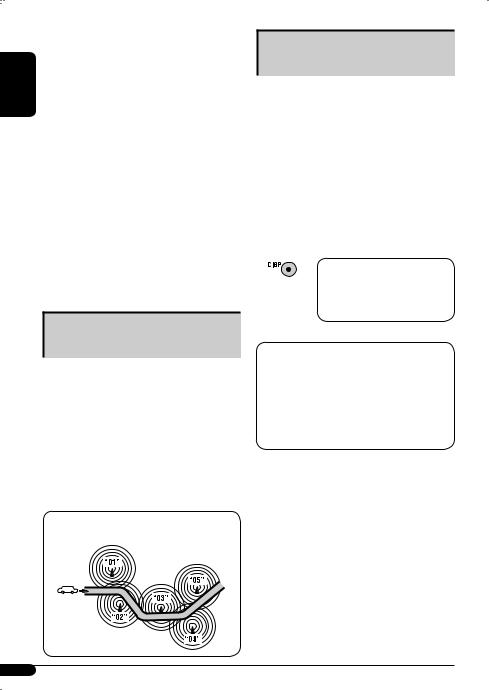
 PTY Standby Reception
PTY Standby Reception
ENGLISH |
PTY Standby Reception allows the unit to switch |
|
temporarily to your favorite PTY programme from any |
||
|
||
|
source other than AM. |
|
|
To activate and select your favorite PTY code for |
|
|
PTY Standby Reception, see page 16. |
|
|
The PTY indicator either lights up or flashes. |
|
|
• If the PTY indicator lights up, PTY Standby Reception |
|
|
is activated. |
|
|
• If the PTY indicator flashes, PTY Standby Reception is |
|
|
not yet activated. |
|
|
To activate PTY Standby Reception, tune in to another |
|
|
station providing these signals. The PTY indicator will |
|
|
stop flashing and remain lit. |
|
|
To deactivate the PTY Standby Reception, select |
|
|
“OFF” for the PTY code (see page 16). The PTY indicator |
|
|
goes off. |
Tracing the same programme— Network-Tracking Reception
When driving in an area where FM reception is not sufficient enough, this unit automatically tunes in to another FM RDS station of the same network, possibly broadcasting the same programme with stronger signals (see the illustration below).
When shipped from the factory, Network-Tracking Reception is activated.
To change the Network-Tracking Reception setting, see “AF-REG” on page 16.
Programme A broadcasting on different frequency areas (01 – 05)
Automatic station selection— Programme Search
Usually when you press the number buttons, the preset station is tuned in.
If the signals from the FM RDS preset station are not sufficient for good reception, this unit, using the AF data, tunes in to another frequency broadcasting the same programme as the original preset station is broadcasting.
•The unit takes some time to tune in to another station using programme search.
•See also page 16.
To check the current clock time while listening to an FM RDS station
Station name (PS) =Station Frequency =Programme type (PTY) =Clock =(back to the beginning)
PTY codes
NEWS, AFFAIRS, INFO, SPORT, EDUCATE, DRAMA, CULTURE, SCIENCE, VARIED, POP M (music), ROCK M (music), EASY M (music), LIGHT M (music), CLASSICS, OTHER M (music), WEATHER, FINANCE, CHILDREN, SOCIAL, RELIGION, PHONE IN, TRAVEL, LEISURE, JAZZ, COUNTRY, NATION M (music), OLDIES, FOLK M (music), DOCUMENT
10
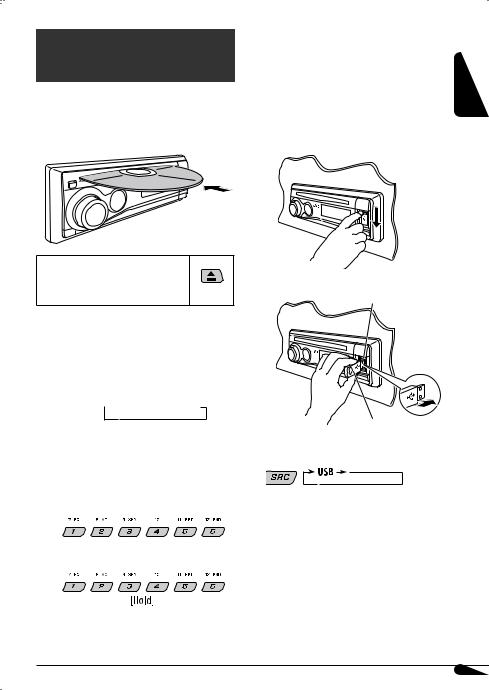
Disc / USB memory operations
Playing a disc in the unit 
All tracks will be played repeatedly until you change the source or eject the disc.
To stop play and eject the disc
• Press SRC to listen to another playback source.
Playing discs in the CD changer 
All discs in the magazine will be played repeatedly until you change the source.
• Ejecting the magazine will also stop playback.
~ 










*If you have changed the external input setting to “EXT IN” (see page 17), you cannot select the CD changer.
ŸSelect a disc.
For disc number from 01 – 06:
For disc number from 07 – 12:
Playing from a USB memory 
This unit can play MP3/WMA tracks stored in a USB |
ENGLISH |
until you change the source. |
|
memory. |
|
All tracks in the USB memory will be played repeatedly |
|
•Removing the USB memory will also stop playback. Then, press SRC to listen to another playback source.
~
Ÿ |
USB input terminal |
USB memory
If a USB memory has been attached...
Playback starts from where it has been stopped previously.
•If a different USB memory is currently attached, playback starts from the beginning.
To detach the USB memory, straightly pull it out from the unit.
Continued on the next page
11
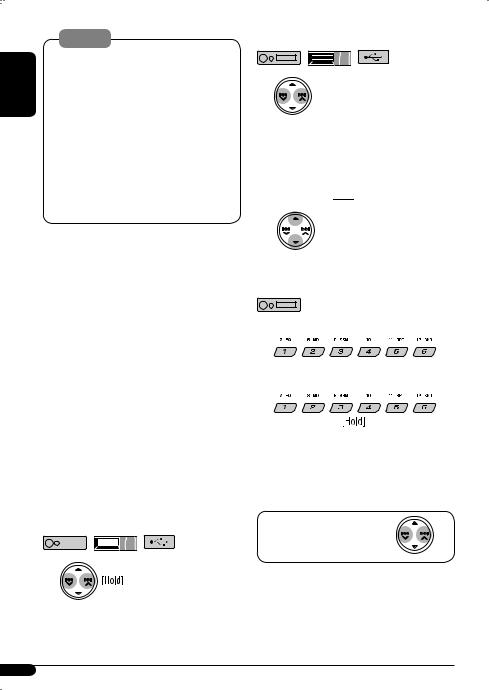
Cautions:
ENGLISH |
• Avoid using the USB memory if it might hinder |
|||||||
your safety driving. |
||||||||
|
||||||||
|
• Do not pull out or attach the USB memory |
|||||||
|
repeatedly while “CHECK” appears on the display. |
|||||||
|
• Operation and power supply may not work as |
|||||||
|
intended for some USB memories. |
|||||||
|
• You cannot connect a computer to the USB input |
|||||||
|
terminal of the unit. |
|||||||
|
• Make sure all important data has been backed up |
|||||||
|
to avoid losing the data. |
|||||||
|
• Some USB memories may not work immediately |
|||||||
|
after you turn on the power. |
|||||||
|
About MP3 and WMA tracks |
|||||||
|
MP3 and WMA “tracks” (words “file” and “track” are |
|||||||
|
used interchangeably) are recorded in “folders.” |
|||||||
|
About the CD changer |
|||||||
|
It is recommended to use a JVC MP3-compatible CD |
|||||||
|
changer with your unit. |
|||||||
|
• You can also connect MP3-incompatible CD changers. |
|||||||
|
However, these units are not compatible with MP3 |
|||||||
|
discs. |
|||||||
|
• You cannot use the CH-X99, CH-X100, and KD-MK |
|||||||
|
series CD changers with this unit. |
|||||||
|
• You cannot play any WMA disc in the CD changer. |
|||||||
|
• Disc text information recorded in the CD Text can be |
|||||||
|
displayed when a JVC CD Text compatible CD changer |
|||||||
|
is connected. |
|||||||
|
• For connection, see Installation/Connection Manual |
|||||||
|
(separate volume). |
|||||||
|
To fast-forward or reverse the track |
|||||||
|
|
|
|
|
|
|
|
|
To go to the next or previous tracks
To go to the next or previous folders (only for MP3/WMA/USB)
For MP3 discs: 

 For WMA discs:
For WMA discs: 

To locate a particular track (for CD) or folder (for MP3/WMA) directly
To select a number from 01 – 06:
To select a number from 07 – 12:
•To use direct folder access on MP3/WMA, it is required that folders are assigned with 2-digit numbers at the beginning of their folder names— 01, 02, 03, and so on.
To select a particular track in a folder (for MP3/WMA):
12
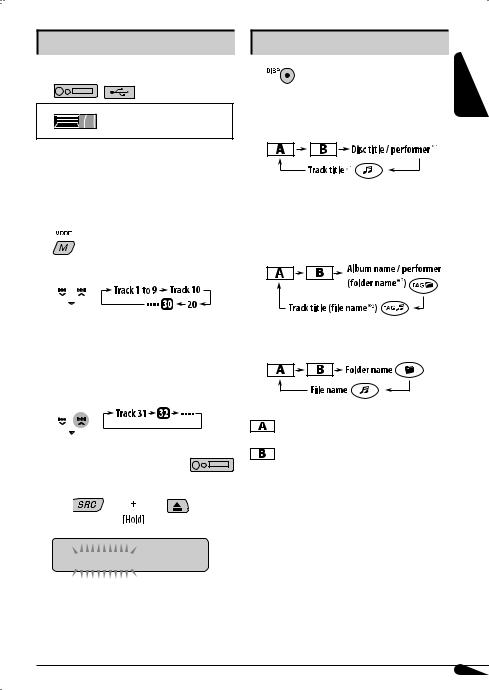
Other main functions
 Skipping tracks quickly during play
Skipping tracks quickly during play
Only possible on JVC
MP3-compatible CD changer
•For MP3/WMA/USB, you can skip tracks within the same folder.
Ex.: To select track 32 while playing a track whose number is a single digit (1 to 9)
1
2 
Each time you press the button, you can skip 10 tracks.
•After the last track, the first track will be selected and vice versa.
Changing the display information
 While playing an audio CD or a CD Text
While playing an audio CD or a CD Text
 While playing an MP3/WMA*2 disc or
While playing an MP3/WMA*2 disc or
USB memory
•When “TAG DISP” is set to “TAG ON” (see page 17)
• When “TAG DISP” is set to “TAG OFF”
ENGLISH
3 
 Prohibiting disc ejection
Prohibiting disc ejection
You can lock a disc in the loading slot.
 NO EJECT
NO EJECT
To cancel the prohibition, repeat the same procedure.
: Elapsed playing time with the current track number
: Clock with the current track number
*1 If the current disc is an audio CD, “NO NAME” appears. *2 Only for the built-in CD player and external USB
memory.
*3 If an MP3/WMA file does not have Tag information, folder name and file name appear. In this case, the TAG indicator will not light up.
13
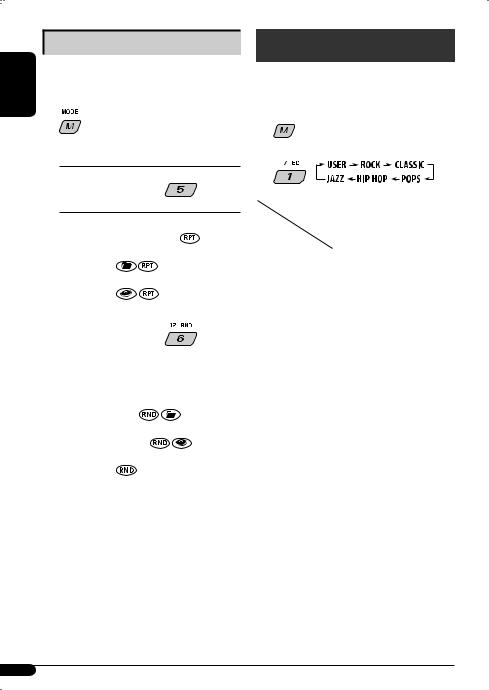
Selecting the playback modes
ENGLISH |
You can use only one of the following playback modes |
|
|
|
at a time. |
|
1 |
2Select your desired playback mode.
7 Repeat play 

Mode |
|
Plays repeatedly |
|
TRK RPT |
: |
The current track. |
|
FLDR RPT *1 : |
All tracks of the current folder. |
||
DISC RPT *2 |
: |
All tracks of the current disc. |
|
RPT OFF |
: |
Cancels. |
|
7 |
Random play |
||
|
|
|
|
Mode |
|
Plays at random |
|
FLDR RND *1 : |
All tracks of the current folder, |
||
|
|
|
then tracks of the next folder and |
|
|
|
so on. |
DISC RND |
: |
All tracks of the current disc or USB |
|
|
|
|
memory. |
MAG RND *2 : |
All tracks of the inserted discs. |
||
RND OFF |
: |
Cancels. |
|
|
|
||
*1 |
Only while playing a media (MP3/WMA/USB). |
||
*2 |
Only while playing discs in the CD changer. |
||
Sound adjustments
You can select a preset sound mode suitable to the music genre (iEQ: intelligent equalizer).
1 

2
|
Preset values |
|
|
|
|
|
|
|
BAS*1 |
MID*2 |
TRE*3 |
LOUD*4 |
|
Indication (For) |
|
|
|
|
||
USER |
00 |
00 |
00 |
OFF |
||
(Flat sound) |
||||||
|
|
|
|
|||
|
|
|
|
|
||
ROCK |
+03 |
00 |
+02 |
ON |
||
(Rock or disco music) |
||||||
|
|
|
|
|||
|
|
|
|
|
||
CLASSIC |
+01 |
00 |
+03 |
OFF |
||
(Classical music) |
||||||
|
|
|
|
|||
|
|
|
|
|
||
POPS |
+02 |
+01 |
+02 |
OFF |
||
(Light music) |
||||||
|
|
|
|
|||
|
|
|
|
|
||
HIP HOP |
+04 |
–02 |
+01 |
ON |
||
(Funk or rap music) |
||||||
|
|
|
|
|||
|
|
|
|
|
||
JAZZ |
+03 |
00 |
+03 |
OFF |
||
(Jazz music) |
||||||
|
|
|
|
|||
|
|
|
|
|
|
|
*1 |
Bass |
|
|
|
|
|
*2 Mid-range |
|
|
|
|
||
*3 |
Treble |
|
|
|
|
|
*4 |
Loudness |
|
|
|
|
|
14
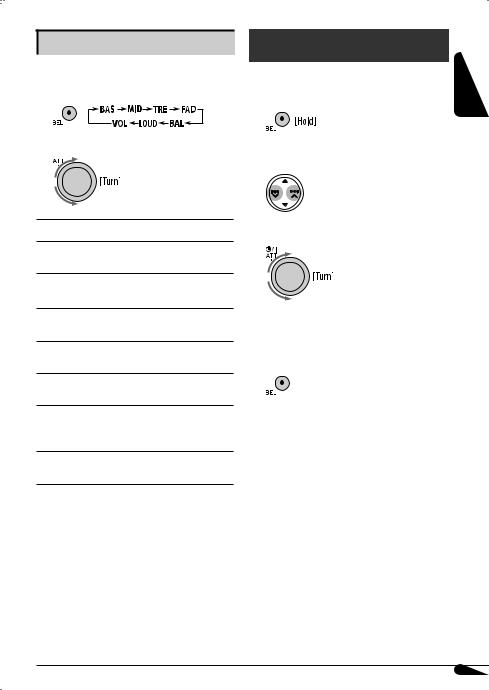
Adjusting the sound
You can adjust the sound characteristics to your preference.
1
2 

Indication, [Range]
BAS*1 (bass), [–06 to +06]
Adjust the bass.
MID*1 (mid-range), [–06 to +06]
Adjust the mid-range frequencies sound level.
TRE*1 (treble), [–06 to +06]
Adjust the treble.
FAD*2 (fader), [R06 to F06]
Adjust the front and rear speaker balance.
BAL (balance), [L06 to R06]
Adjust the left and right speaker balance.
LOUD*1 (loudness), [LOUD ON or LOUD OFF] Boost low and high frequencies to produce a wellbalanced sound at low volume level.
VOL (volume), [00 to 30 or 50*3]
Adjust the volume.
*1 When you adjust the bass, mid-range, treble, or loudness, the adjustment you have made is stored for the currently selected sound mode (iEQ) including “USER.”
*2 If you are using a two-speaker system, set the fader level to “00.”
*3 Depending on the amplifier gain control setting. (See page 17 for details.)
General settings — PSM
You can change PSM (Preferred Setting Mode) items listed in the table that follows.
1
2 Select a PSM item.
3 Adjust the PSM item selected.
4Repeat steps 2 and 3 to adjust other PSM items if necessary.
5 Finish the procedure.
ENGLISH
Continued on the next page
15

ENGLISH
Indications |
Item |
Selectable settings, [reference page] |
||
|
( |
|
: Initial) |
|
|
|
|
|
|
DEMO |
• DEMO ON |
: Display demonstration will be activated automatically if no |
||
Display |
|
|
|
operation is done for about 20 seconds, [7]. |
demonstration |
• DEMO OFF |
: Cancels. |
||
|
|
|
|
|
CLK DISP *1 |
• ON |
: Clock time is shown on the display at all times when the power is |
||
Clock display |
|
|
|
turned off. |
|
• |
OFF |
: Cancels; pressing DISP will show the clock time for about 5 seconds |
|
|
|
|
|
when the power is turned off, [7]. |
|
|
|
|
|
CLOCK H |
0 – 23 (1 – 12) |
[Initial: 0 (0:00)], [7]. |
||
Hour adjustment |
|
|
|
|
|
|
|
|
|
CLOCK M |
00 – 59 |
[Initial: 00 (0:00)], [7]. |
||
Minute adjustment |
|
|
|
|
|
|
|
|
|
24H/12H |
• 24H |
: See also page 7 for setting. |
||
Time display mode |
• 12H |
|
||
|
|
|
|
|
CLK ADJ *2 |
• AUTO |
: The built-in clock is automatically adjusted using the CT (clock |
||
Clock adjustment |
|
|
|
time) data in the RDS signal. |
|
• OFF |
: Cancels. |
||
|
|
|
|
|
AF-REG *2 |
• AF |
: When the currently received signals become weak, the unit |
||
Alternative frequency/ |
|
|
|
switches to another station (the programme may differ from the |
regionalization |
|
|
|
one currently received), [10]. |
reception |
|
|
|
• The AF indicator lights up. |
|
• AF REG |
: When the currently received signals become weak, the unit |
||
|
|
|
|
switches to another station broadcasting the same programme. |
|
|
|
|
• The AF and REG indicators light up. |
|
• OFF |
: Cancels (not selectable when “DAB AF“ is set to “AF ON“). |
||
|
|
|
|
|
PTY-STBY*2 |
OFF, PTY codes |
: Activates PTY Standby Reception with one of the PTY codes, [10]. |
||
PTY standby |
|
|
|
|
|
|
|
|
|
TA VOL*2 |
VOL 00 – |
[Initial: VOL 15] |
||
Traffic announcement |
VOL 30 or 50 *3 |
|
||
volume |
|
|
|
|
|
|
|
|
|
P-SEARCH*2 |
• ON |
: Activates Programme Search, [10]. |
||
Programme search |
• |
OFF |
: Cancels. |
|
|
|
|
|
|
DAB AF*4 |
• AF ON |
: Traces the programme among DAB services and FM RDS stations, |
||
Alternative frequency |
|
|
|
[10, 18]. |
reception |
• AF OFF |
: Cancels. |
||
|
|
|
|
|
16

Indications |
Item |
Selectable settings, [reference page] |
|||
|
|
( |
|
: Initial) |
|
|
|
|
|
|
|
DAB VOL*4 |
VOL –12 |
: [Initial: VOL 00]; You can adjust the volume level of DAB tuner to |
|||
DAB volume |
— VOL +12 |
match the FM sound level and store it in memory. |
|||
adjustment |
|
|
|
|
|
|
|
|
|
||
DIMMER |
• AUTO |
: Dims the display when you turn on the headlights. |
|||
Dimmer |
• ON |
: Activates dimmer. |
|||
|
|
• OFF |
: Cancels. |
||
|
|
|
|
||
TEL |
• MUTING 1/ |
: Select either one which mutes the sounds while using a cellular |
|||
Telephone muting |
|
MUTING 2 |
phone. |
||
|
|
• |
OFF |
: Cancels. |
|
|
|
|
|
||
SCROLL *5 |
• ONCE |
: Scrolls the track information once. |
|||
Scroll |
• AUTO |
: Repeats scrolling (at 5-second intervals). |
|||
|
|
• OFF |
: Cancels. |
||
|
|
|
|
|
• Pressing DISP for more than one second can scroll the display |
|
|
|
|
|
regardless of the setting. |
|
|
|
|
|
|
EXT IN*6 |
• |
CHANGER |
: To use a JVC CD changer, [11], JVC DAB tuner, [18], an Apple iPod or a |
||
External input |
|
|
|
JVC D. player, [19]. |
|
|
|
• |
EXT IN |
: To use any other external component than the above, [21]. |
|
|
|
|
|
||
TAG DISP |
• TAG ON |
: Shows the Tag information while playing MP3/WMA tracks, [13]. |
|||
Tag display |
• TAG OFF |
: Cancels. |
|||
|
|
|
|
||
AMP GAIN |
• LOW PWR |
: VOL 00 – VOL 30 (Select this if the maximum power of the speaker is |
|||
Amplifier gain |
|
|
|
less than 50 W to prevent damaging the speaker.) |
|
control |
• |
HIGH PWR |
: VOL 00 – VOL 50 |
||
|
|
|
|
||
IF BAND |
• AUTO |
: Increases the tuner selectivity to reduce interference noises between |
|||
Intermediate |
|
|
|
close stations. (Stereo effect may be lost.) |
|
frequency band |
• WIDE |
: Subject to interference noises from adjacent stations, but sound |
|||
|
|
|
|
|
quality will not be degraded and the stereo effect will remain. |
|
|
|
|||
*1 |
If the power supply is not interrupted by turning off the ignition key of your car, it is recommended to select “OFF” to |
||||
|
save the car’s battery. |
|
|
|
|
*2 |
Only for FM RDS stations. |
|
|||
*3 |
Depends on the amplifier gain control. |
|
|||
*4 |
Displayed only when DAB tuner is connected. |
||||
*5 |
Some characters or symbols will not be shown correctly (or will be blanked) on the display. |
||||
*6 |
Displayed only when one of the following sources is selected—FM, AM, CD, or USB. |
||||
ENGLISH
17
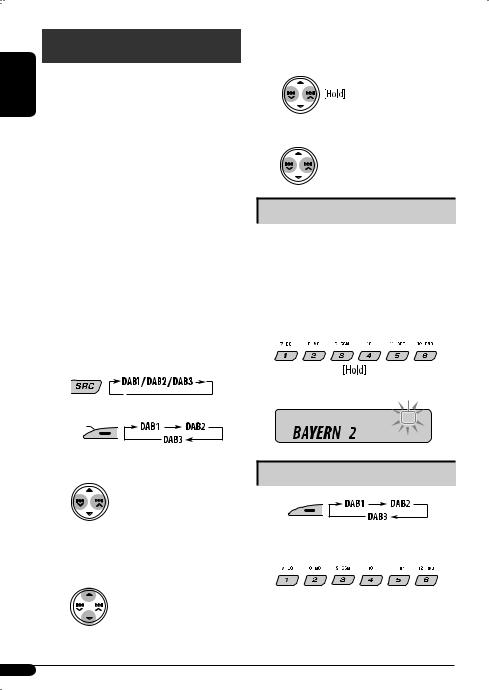
ENGLISH
DAB tuner operations
What is DAB system?
Digital Audio Broadcasting (DAB) can deliver digital quality sound without any annoying interference and signal distortion. Furthermore, it can carry text, pictures, and data. When transmitting, DAB combines several programmes (called “services”) to form one “ensemble.” In addition, each “service”—called “primary service”—can also be divided into its components (called “secondary service”). A typical ensemble has six or more programmes (services) broadcast at the same time.
By connecting the DAB tuner, this unit can do the following:
•Tracing the same programme automatically —Alternative Frequency Reception (see “DAB AF” on page 16).
It is recommended to use DAB tuner KT-DB1000 with your unit. If you have another DAB tuner, consult your JVC IN-CAR ENTERTAINMENT dealer.
•Refer also to the Instructions supplied for your DAB tuner.
~
Ÿ 

! Start searching for an ensemble.
When an ensemble is received, searching stops.
To stop searching, press the same button again.
⁄Select a service (either primary or secondary) to listen to.
To tune in to an ensemble manually
Start searching for an ensemble, as in step !on the left column.
1
2 Select a desired ensemble frequency.
Storing DAB services in memory
You can preset six DAB services (primary) for each band.
1Select a service you want (see steps ~to ⁄ on the left column).
2Select the preset number (1 – 6) you want to store into.
Preset number flashes for a while.
 P4
P4 
Tuning in to a preset DAB service
1 


2Select the preset DAB service (primary) number (1 – 6) you want.
If the selected primary service has some secondary services, pressing the same button again will tune in to the secondary services.
18
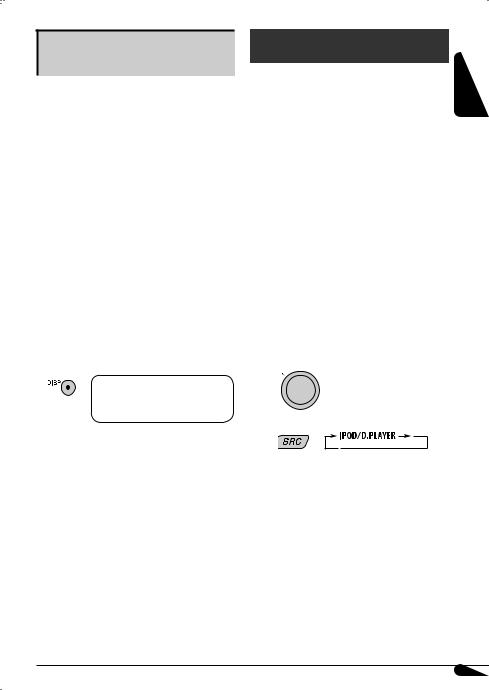
Tracing the same programme— Alternative Frequency Reception
You can keep listening to the same programme by activating the Alternative Frequency Reception.
•While receiving a DAB service:
When driving in an area where a service cannot be received, this unit automatically tunes in to another ensemble or FM RDS station, broadcasting the same programme.
•While receiving an FM RDS station:
When driving in an area where a DAB service is broadcasting the same programme as the FM RDS station is broadcasting, this unit automatically tunes in to the DAB service.
When shipped from the factory, Alternative Frequency Reception is activated.
To deactivate the Alternative Frequency Reception, see page 16.
To change the display information while tuning to an ensemble
Service name =Ensemble name
=Channel number =Frequency
=Clock =(back to the beginning)
iPod / D. player operations
This unit is ready for operating an Apple iPod or a JVC D. player from the control panel.
Before operating your iPod or D. player: Connect either one of the following (separately
purchased) to the CD changer jack on the rear of this unit.
•Interface adapter for iPod—KS-PD100 for controlling an iPod.
•D. player interface adapter—KS-PD500 for controlling a D. player.
•For connection, see Installation/Connection Manual (separate volume).
•For details, refer also to the manual supplied with the interface adapter.
Preparations:
Make sure “CHANGER” is selected for the external input setting, see page 17.
~ 

Ÿ
Playback starts automatically from where it has been paused*1 or stopped*2 previously.
ENGLISH
Continued on the next page
19
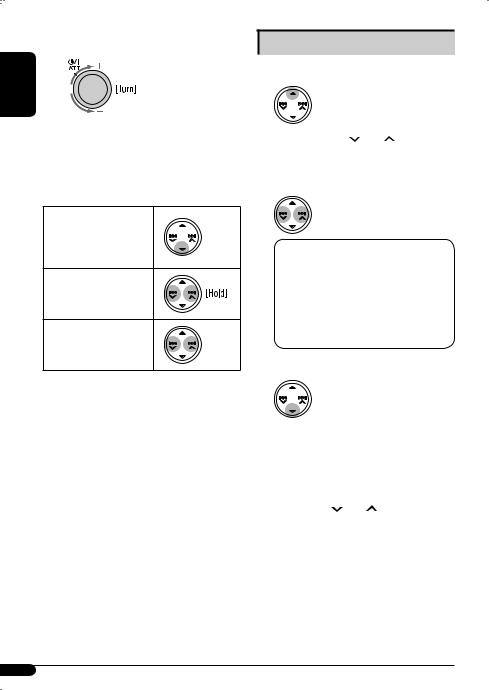
! Adjust the volume.
ENGLISH
⁄Adjust the sound as you want. (See pages 14 and 15.)
• Make sure the equalizer on the iPod or D. player is deactivated.
To pause*1 or stop*2 playback
To resume playback, press the button again.
To fast-forward or reverse the track
To go to the next or previous tracks
*1 For iPod
*2 For D. player
Selecting a track from the menu
1 Enter the main menu.
Now the 5/∞/4 /¢ buttons work as the menu selecting buttons*.
2 Select the desired menu.
For iPod:
PLAYLIST ÔARTISTS ÔALBUMS Ô SONGS ÔGENRES ÔCOMPOSER Ô
(back to the beginning)
For D. player:
PLAYLIST ÔARTIST ÔALBUM Ô GENRE ÔTRACK Ô(back to the beginning)
3 Confirm the selection.
To move back to the previous menu, press 5.
•If a track is selected, playback starts automatically.
•If the selected item has another layer, you will enter the layer. Repeat steps 2 and 3 until the
desired track is played.
• Holding 4 /¢ can skip 10 items at
atime.
* The menu selecting mode will be canceled:
–If no operations are done for about 5 seconds.
–When you confirm the selection of a track.
20
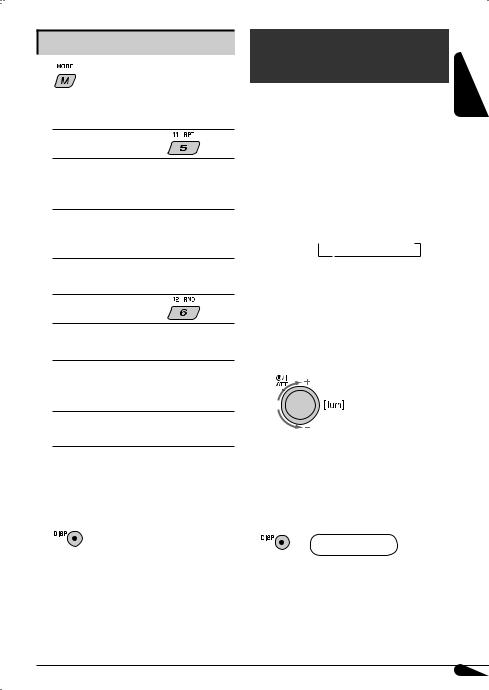
Selecting the playback modes
1
2 Select your desired playback mode.
7 Repeat play
ONE RPT 
Functions the same as “Repeat One” of the iPod or “Repeat Mode =One” for the D. player.
ALL RPT 
Functions the same as “Repeat All” of the iPod or “Repeat Mode =All” for the D. player.
RPT OFF
Cancels.
7 Random play
ALBM RND* 
Functions the same as “Shuffle Albums” of the iPod.
SONG RND/RND ON 
Functions the same as “Shuffle Songs” of the iPod or “Random Play =On” of the D. player.
RND OFF
Cancels.
*For iPod: Functions only if you select “ALL” in “ALBUMS” of the main “MENU.”
To check other information while listening to an iPod or a D. player
Other external component operations
You can connect an external component to the CD changer jack on the rear using the Line Input Adapter—KS-U57 (not supplied) or AUX Input Adapter—KS-U58 (not supplied).
•For connection, see Installation/Connection Manual (separate volume).
•For listening to the USB memory, see pages 11 and 12; For DAB tuner, see pages 18 and 19; For iPod or D. player, see pages 19 – 21.
~ 











If “EXT IN” does not appear, see page 17 and select the external input (“EXT IN”).
ŸTurn on the connected component and start playing the source.
! Adjust the volume.
⁄Adjust the sound as you want. (See pages 14 and 15.)
To check other information while listening to an external component
EXT IN ÔClock
ENGLISH
21
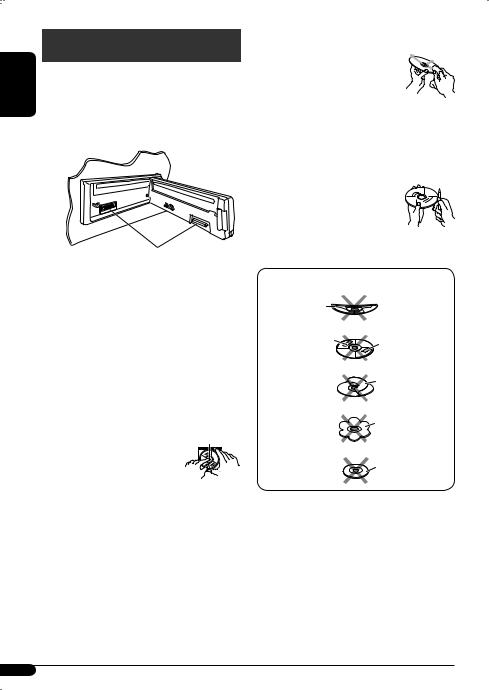
ENGLISH
Maintenance
 How to clean the connectors
How to clean the connectors
Frequent detachment will deteriorate the connectors. To minimize this possibility, periodically wipe the connectors with a cotton swab or cloth moistened with alcohol, being careful not to damage the connectors.
 To keep discs clean
To keep discs clean
A dirty disc may not play correctly.
If a disc does become dirty, wipe it with a soft cloth in a straight line from center to edge.
•Do not use any solvent (for example, conventional record cleaner, spray, thinner, benzine, etc.) to clean discs.
Connector
 Moisture condensation
Moisture condensation
Moisture may condense on the lens inside the unit in the following cases:
•After starting the heater in the car.
•If it becomes very humid inside the car.
Should this occur, the unit may malfunction. In this case, eject the disc and leave the unit turned on for a few hours until the moisture evaporates.
 How to handle discs
How to handle discs
When removing a disc from its |
Center holder |
case, press down the center holder |
|
of the case and lift the disc out, |
|
holding it by the edges. |
|
•Always hold the disc by the edges. Do not touch its recording surface.
When storing a disc into its case, gently insert the disc around the center holder (with the printed surface facing up).
• Make sure to store discs into the cases after use.
 To play new discs
To play new discs
New discs may have some rough spots around the inner and outer edges. If such a disc is used, this unit may reject the disc.
To remove these rough spots, rub the edges with a pencil or ball-point pen, etc.
Do not use the following discs:
Warped disc |
|
Sticker |
Sticker residue |
|
|
|
Stick-on label |
|
Unusual shape |
|
Single CD (8 cm disc) |
22

More about this unit
Basic operations 
Turning on the power
•By pressing SRC on the unit, you can also turn on the power. If the source is ready, playback also starts.
Turning off the power
•If you turn off the power while listening to a disc, disc play will start from where playback has been stopped previously, next time you turn on the power.
Tuner operations 
Storing stations in memory
•During SSM search...
–All previously stored stations are erased and stations are stored newly.
–Received stations are preset in No. 1 (lowest frequency) to No. 6 (highest frequency).
–When SSM is over, the station stored in No. 1 will be automatically tuned in.
•When storing a station manually, the previously preset station is erased when a new station is stored in the same preset number.
FM RDS operations
•Network-Tracking Reception requires two types of RDS signals—PI (Programme Identification) and AF (Alternative Frequency) to work correctly. Without receiving these data correctly, Network-Tracking Reception will not operate correctly.
•If a Traffic Announcement is received by TA Standby Reception, the volume level automatically changes to the preset level (TA VOL) if the current level is lower than the preset level.
•When Alternative Frequency Reception is activated (with AF selected), Network-Tracking Reception is also activated automatically. On the other hand, Network-Tracking Reception cannot be deactivated without deactivating Alternative Frequency Reception. (See page 16.)
• If you want to know more about RDS, visit <http://www.rds.org.uk>.
Disc operations |
|
ENGLISH |
|
|
|
Caution for DualDisc playback |
|
|
• The Non-DVD side of a “DualDisc” does not comply |
|
|
with the “Compact Disc Digital Audio” standard. |
|
|
Therefore, the use of Non-DVD side of a DualDisc on |
|
|
this product may not be recommended. |
|
|
General
•This unit has been designed to reproduce CDs/CD Texts, and CD-Rs (Recordable)/CD-RWs (Rewritable) in audio CD (CD-DA), MP3 and WMA formats.
•When a disc is inserted upside down, “PLEASE” and “EJECT” appear alternately on the display. Press 0to eject the disc.
•While fast-forwarding or reversing on an MP3 or WMA disc, you can only hear intermittent sounds.
Playing a CD-R or CD-RW
•Use only “finalized” CD-Rs or CD-RWs.
•This unit can play back only files of the same type which are first detected if a disc includes both audio CD (CD-DA) files and MP3/WMA files.
•This unit can play back multi-session discs; however, unclosed sessions will be skipped while playing.
•Some CD-Rs or CD-RWs may not be played back on this unit because of their disc characteristics, or for the following reasons:
–Discs are dirty or scratched.
–Moisture condensation occurs on the lens inside the unit.
–The pickup lens inside the unit is dirty.
–CD-R/CD-RW on which the files are written with “Packet Write” method.
–There are improper recording conditions (missing data, etc.) or media conditions (stained, scratched, warped, etc.).
•CD-RWs may require a longer readout time since the reflectance of CD-RWs is lower than that of regular CDs.
Continued on the next page
23

ENGLISH
•Do not use the following CD-Rs or CD-RWs:
–Discs with stickers, labels, or protective seal stuck to the surface.
–Discs on which labels can be directly printed by an ink jet printer.
Using these discs under high temperatures or high humidities may cause malfunctions or damage to the unit.
Playing an MP3/WMA disc
•This unit can play back MP3/WMA files with the extension code <.mp3> or <.wma> (regardless of the letter case—upper/lower).
•This unit can show the names of albums, artists (performer), and Tag (Version 1.0, 1.1, 2.2, 2.3, or 2.4) for MP3 files and for WMA files.
•This unit can display only one-byte characters. No other characters can be correctly displayed.
•This unit can play back MP3/WMA files meeting the conditions below:
–Bit rate of MP3: 8 kbps — 320 kbps
–Sampling frequency of MP3:
48 kHz, 44.1 kHz, 32 kHz (for MPEG-1) 24 kHz, 22.05 kHz, 16 kHz (for MPEG-2) 12 kHz, 11.025 kHz, 8 kHz (for MPEG-2.5)
–Bit rate of WMA: 16 kbps — 32 kbps
(Sampling frequency: 22.05 kHz) 32 kbps — 320 kbps
(Sampling frequency: 48 kHz,
44.1kHz, 32 kHz)
–Disc format: ISO 9660 Level 1/ Level 2, Romeo, Joliet, Windows long file name
•The maximum number of characters for file/folder names vary among the disc format used (includes 4 extension characters—<.mp3> or <.wma>).
–ISO 9660 Level 1: up to 12 characters
–ISO 9660 Level 2: up to 31 characters
–Romeo: up to 128 characters
–Joliet: up to 64 characters
–Windows long file name: up to 128 characters
•This unit can recognize a total of 512 files, of 200 folders, and of 8 hierarchies.
•This unit can play back files recorded in VBR (variable bit rate).
Files recorded in VBR have a discrepancy in elapsed time display, and do not show the actual elapsed time. Especially, after performing the search function, this difference becomes noticeable.
•This unit cannot play back the following files:
–MP3 files encoded with MP3i and MP3 PRO format.
–MP3 files encoded in an inappropriate format.
–MP3 files encoded with Layer 1/2.
–WMA files encoded with lossless, professional, and voice format.
–WMA files which are not based upon Windows Media® Audio.
–WMA files copy-protected with DRM.
–Files which have the data such as AIFF, ATRAC3, etc.
•The search function works but search speed is not constant.
Playing MP3/WMA tracks from a USB memory
•While playing from a USB memory, the playback order may differ from other players.
•This unit may be unable to play back some USB memories or some files due to their characteristics or recording conditions.
•Depending on the shape of the USB memories and connection ports, some USB memories may not be attached properly or the connection might be loose.
•If the connected USB memory does not have the correct files, “NO FILE” appears.
•This unit can show Tag (Version 1.0, 1.1, 2.2, 2.3, or 2.4) for MP3 files and for WMA files.
•This unit can play back MP3/WMA files meeting the conditions below:
–Bit rate of MP3: 16 kbps — 320 kbps
–Sampling frequency of MP3:
48 kHz, 44.1 kHz, 32 kHz (for MPEG-1) 24 kHz, 22.05 kHz, 16 kHz (for MPEG-2) 12 kHz, 11.025 kHz, 8 kHz (for MPEG-2.5)
–Bit rate of WMA: 16 kbps — 32 kbps
(Sampling frequency: 22.05 kHz) 32 kbps — 320 kbps
(Sampling frequency: 48 kHz, 44.1 kHz, 32 kHz)
24
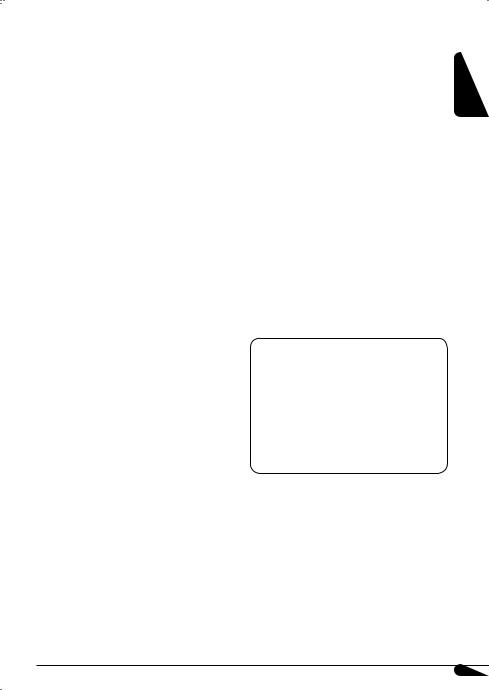
•This unit can play back MP3 files recorded in VBR (variable bit rate).
•The maximum number of characters for:
–Folder names : 20 characters
–File names : 25 characters
–MP3 Tag : 128 characters
–WMA Tag : 64 characters
•This unit can recognize a total of 2 500 files, 250 folders (999 files per folder), and of 8 hierarchies.
•This unit does not support SD card reader.
•This unit cannot play back the following files:
–MP3 files encoded with MP3i and MP3 PRO format.
–MP3 files encoded in an inappropriate format.
–MP3 files encoded with Layer 1/2.
Changing the source
•If you change the source, playback also stops.
Next time you select the same source again, playback starts from where it has been stopped previously.
Ejecting a disc
•If the ejected disc is not removed within 15 seconds, the disc is automatically inserted again into the loading slot to protect it from dust.
•After ejecting a disc or removing a USB memory, “NO DISC” or “NO USB“ appears and you cannot operate some of the buttons. Insert another disc, reattach a USB memory, or press SRC to select another playback source.
General settings—PSM 
•“AUTO” setting for “DIMMER” may not work correctly on some vehicles, particularly on those having a control dial for dimming.
In this case, change the “DIMMER” setting to any other than “AUTO.”
•If you change the “AMP GAIN” setting from
“HIGH PWR” to “LOW PWR” while the volume level is set higher than “VOL 30,” the unit automatically changes the volume level to “VOL 30.”
DAB tuner operations 
• |
Only primary DAB services can be presetted even |
ENGLISH |
|
when you store a secondary service. |
|
|
|
|
• |
A previously preset DAB service is erased when a new |
|
|
DAB service is stored in the same preset number. |
|
iPod or D. player operations 
•When you turn on this unit, the iPod or D. player is charged through this unit.
•While the iPod or D. player is connected, all operations from the iPod or D. player are disabled. Perform all operations from this unit.
•The text information may not be displayed correctly.
–Some characters such as accented letters cannot be shown correctly on the display.
–Depends on the condition of communication between the iPod or D. player and the unit.
•If the text information includes more than 8 characters, it scrolls on the display (see also page 17). This unit can display up to 40 characters.
Notice:
When operating an iPod or a D. player, some operations may not be performed correctly or as intended. In this case, visit the following JVC web site:
For iPod users: <http://www.jvc.co.jp/english/car/ support/ks-pd100/index.html>
For D. player users: <http://www.jvc.co.jp/ english/car/support/ks-pd500/index.html>
25

ENGLISH
Troubleshooting
What appears to be trouble is not always serious. Check the following points before calling a service center.
|
|
|
Symptoms |
Remedies/Causes |
|
General |
|
• Sound cannot be heard from the speakers. |
• Adjust the volume to the optimum level. |
||
|
|
|
• Check the cords and connections. |
||
|
|
|
|
||
|
|
|
|
||
|
|
• The unit does not work at all. |
Reset the unit (see page 2). |
||
|
|
|
|
||
FM/AM |
|
• SSM automatic presetting does not work. |
Store stations manually. |
||
|
|
|
|
||
• |
Static noise while listening to the radio. |
Connect the aerial firmly. |
|||
|
|
|
|
||
|
|
• Disc cannot be played back. |
Insert the disc correctly. |
||
|
|
|
|
||
|
|
• CD-R/CD-RW cannot be played back. |
• Insert a finalized CD-R/CD-RW. |
||
|
|
• Tracks on the CD-R/CD-RW cannot be |
• Finalize the CD-R/CD-RW with the component which you |
||
playback |
|
|
skipped. |
used for recording. |
|
|
|
|
|
||
• Disc can neither be played back nor ejected. |
• Unlock the disc (see page 13). |
||||
|
|
||||
Disc |
|
|
|
• Eject the disc forcibly (see page 2). |
|
|
|
|
|
||
|
• Disc sound is sometimes interrupted. |
• Stop playback while driving on rough roads. |
|||
|
|
||||
|
|
|
|
• Change the disc. |
|
|
|
|
|
• Check the cords and connections. |
|
|
|
|
|
||
|
|
• “NO DISC” appears on the display. |
Insert a playable disc into the loading slot. |
||
|
|
• Disc cannot be played back. |
• Use a disc with MP3/WMA tracks recorded in the |
||
|
|
|
|
format compliant with ISO 9660 Level 1, Level 2, |
|
|
|
|
|
Romeo, or Joliet. |
|
|
|
|
|
• Add the extension code <.mp3> or <.wma> to the |
|
|
|
|
|
file names. |
|
|
|
|
|
|
|
|
|
• |
Noise is generated. |
Skip to another track or change the disc. (Do not add the |
|
playback |
|
• |
A longer readout time is required (“CHECK” |
extension code <.mp3> or <.wma> to non-MP3 or |
|
|
Do not use too many hierarchies and folders. |
||||
|
|
|
|
WMA tracks.) |
|
MP3/WMA |
|
|
have intended. |
|
|
|
|
|
keeps flashing on the display). |
|
|
|
|
• Tracks are not played back in the order you |
Playback order is determined when the files are recorded. |
||
|
|
|
|
||
|
|
• Elapsed playing time is not correct. |
This sometimes occurs during play. This is caused by how |
||
|
|
|
|
the tracks are recorded on the disc. |
|
|
|
|
|
||
|
|
• “PLEASE” and “EJECT” appear alternately on |
Insert a disc that contains MP3/WMA tracks. |
||
|
|
|
the display. |
|
|
|
|
|
|
||
|
|
• Correct characters are not displayed (e.g. |
This unit can only display letters (upper case), numbers, |
||
|
|
|
album name). |
and a limited number of symbols. |
|
|
|
|
|
|
|
26
